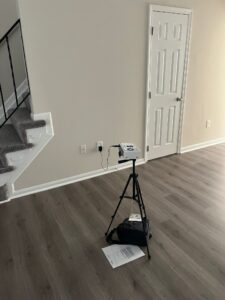Radon is a colorless, odorless gas that seeps into homes from the ground, produced by the natural breakdown of uranium in soil, rock, and water. While undetectable without testing, it poses a serious health risk. Radon is the second leading cause of lung cancer after smoking, responsible for thousands of deaths annually. Testing your Maryland home is the first step to protecting your family from this hidden danger.

How radon gas enters a house with all residential options outline diagram. Labeled educational living space analysis for poisoning pollution vector illustration. Clean air awareness in real estate.
Radon can enter your home through cracks in floors or walls, gaps around pipes, and construction joints. It can also seep in through well water or building materials. Since radon is heavier than air, levels are typically highest in basements and crawl spaces. Testing is the only way to know if your home is affected.
Maryland’s geology makes radon a prevalent issue across the state. Testing your home regularly ensures your family’s safety. Experts recommend testing every two years, especially if you have a basement or lower living spaces. Testing is also critical after home renovations or structural changes, as these can affect radon levels.
Radon levels in homes can vary, so it’s essential to test for radon at least every two years to ensure your home remains safe. However, if you’ve recently renovated or made structural changes to your home, it’s wise to test again, as these alterations can impact radon levels. It’s recommended to conduct radon testing during cooler months when your home is closed up, as this provides the most accurate results. If you find high levels of radon, take immediate steps to mitigate the issue and ensure your home is safe.

Professional testing services offer more accurate results as certified professionals conduct the tests. Professionals may use advanced equipment to ensure precise measurements and offer expert advice on mitigation if high levels of radon are detected in your home. Consider the level of expertise and the importance of accurate results for radon testing in your Maryland home.
The EPA recommends that radon levels in homes be below 4.0 pCi/L. If your home’s radon level exceeds this threshold, it’s time to take action. Professional mitigation systems can significantly reduce radon concentrations, ensuring a safer environment.
Radon levels in homes can be reduced through various mitigation options. Some common methods to lower radon levels include:
A certified radon mitigation professional can help determine the best solution for your home.
Make sure to hire a certified radon mitigation professional when dealing with radon in your Maryland home. These professionals have specific training and knowledge in reducing radon levels to keep your home safe. They are equipped to assess your home, recommend the best mitigation system, and ensure it is installed correctly. Hiring a certified professional gives you peace of mind knowing that an expert is handling the radon issue in your home.
Radon testing is a simple, proactive step to safeguard your family’s health. You can ensure a safe and healthy living environment by identifying and addressing elevated radon levels. Regular testing and mitigation give you peace of mind.
Contact us today to schedule a professional radon test and protect your family’s health!